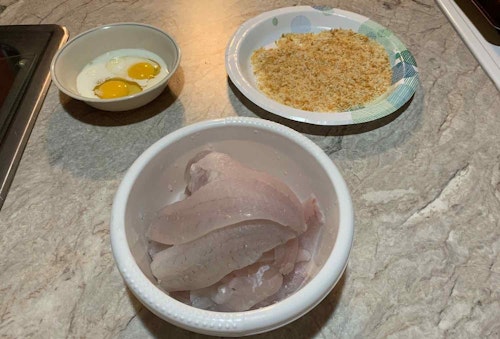Of the many ways for cooking fish, my favorite method — baking — is very simple, and it results in delicious crispy fillets, without making a mess in the process. This has been my go-to method for decades when preparing everything from sunfish and crappies to pike and walleyes.
Step 1: Bleed fish whenever possible.
I’ve covered this topic in a previous Grand View Outdoors article; click here to check it out. Bleeding fish results in blood-free, pearl-white fillets, and less overall mess on the cleaning board.
Step 2: Remove all bones.
If you don’t know how to properly fillet fish, then click here for a quick tutorial. As the video shows, take the extra few seconds to remove the epipleural bones, too. These small bones are located just above the ribcage.
Step 3: Prepare an egg wash.
Depending on how many fillets I’m preparing, I’ll crack one, two or three eggs in a bowl and combine the eggs with a small amount of milk. Beat with a fork.

Step 4: Prepare the breading mix.
There are many types of breading that work well when baking fish. My favorite is Shore Lunch Oven Style, however, it can be difficult to find in local grocery stores. In fact, I have better luck finding it in tackle shops. Of course, you can purchase it online, too.
If I want to cook fish immediately and my supply of Shore Lunch Oven Style is gone, I recently discovered that a seasoned coating mix for baking chicken works well, too. Specifically I tried Oven Fry Extra Crispy Chicken. Even though it’s designed for chicken, it complements the fish flavor, it doesn’t overpower it. To add volume, you can combine the breading mix with bread crumbs, too.
Spread the breading mix on a dinner-sized plate or shallow pan. You want the breading to be about one-eighth inch deep on the plate.

Step 5: Dip and coat the fillets.
To keep your fingers clean and dry, use a fork to dip a single fillet into the egg wash. Allow the excess egg/milk mixture to drip off the fillet before gently laying it on the breading. Use a spoon to cover the top of the fillet with breading. Finally, with dry fingers, press the fillet into the breading to ensure that the backside of the fillet is coated, too. Tip: If fillets are longer than 6 inches, cut them into smaller pieces for easier handling.
Step 6: Place fillets on cookie sheet.
After a fillet is covered in breading on both sides, set it on a cookie sheet that has been lightly covered with baking spray. Repeat step 5 until all fillets are covered and placed on the cookie sheet. Note: Depending on the size and number of fillets and size of your cookie sheet, you might have to use two cookie sheets. Also, you’ll need to continue adding breading mix to the plate as you coat the fillets, and be sure the breading is spread evenly across the plate each time before placing a new fillet onto it. At no point should an egg-washed fillet come into contact with the plate itself.
Step 7: Bake at 400 degrees.
After preheating the oven to 400 degrees, place the cookie sheet (or sheets) with coated fillets in the oven and then cook 10 to 12 minutes if the fillets are a half-inch thick, and up to 15 minutes if they are closer to 1-inch thick. Perfectly baked fillets will flake easily with a fork. When the fish is done cooking, the breading will have turned to a slightly darker brown, especially around the edges, and the fillets will curl slightly, too. Don’t overcook or the fillets will be hard and dry.
In a recent taste test with my two teenage sons, one preferred fillets coated with Shore Lunch Oven Style, and the other liked Oven Fry Extra Crispy Chicken best. I typically serve baked fish with whole kernel corn, a sliced apple, and a side salad. Regardless of breading mix used, I like to dip my fillets (bite by bite) into Kraft Real Mayo.
The next time you have fish fillets to prepare for lunch or dinner, don’t automatically reach for the frying pan and oil. Try baking instead. I think you’ll be pleasantly surprised with the results.







